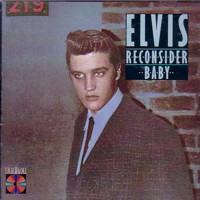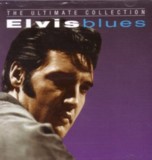

How Elvis was influenced by "The Blues"On a regular basis EIN examines a new release or issue in the Elvis world. In this edition we shine our spotlight on how The Blues influenced Elvis!
Instead Elvis was influenced by the blues as a music genre. Big Mama Thornton, Arthur ‘Big Boy’ Crudup, The Prisonaires, Lowell Fulson, Chuck Berry, Bo Diddley, Little Richard, Fats Domino and many others were all admired by Elvis who recorded many of their songs while traces of their music, delivery and style are evident in many of his other recordings. Blues music largely evolved after the Civil War - a combination of the music of slaves, railroad songs and gospel, backed by a dance beat. That beat became more noticeable with the advent of rhythm and blues.The lyrics of blues songs were usually depressing, dealing with life’s hardships and the woes of love. There were two primary forms (or regions) of blues in America - the electrified (guitar) Chicago blues and the Delta blues of the Mississippi region characterised by the use of harmonicas and acoustic guitars. Growing up in Tupelo, and more importantly Memphis, it is not surprising that the young Elvis Presley quickly appreciated the raw, heartfelt emotion and personal expression emanating from Delta blues music. The southern states of the US had long been a hotbed of complementary and dissimilar musical genres: country, hillbilly, gospel and blues. Moreover, the 1950s was a time of racial change. Increasingly black and whites played alongside each other in clubs and slowly ‘race’ stations which were playing the devil’s music (black rhythm and blues) became accessible to white youth. The stories of Elvis going to Beale Street (‘home of the blues’) to listen to artists such as B. B. King, Little Junior Parker and Rufus Thomas are well known. Blues legend B. B. King in his autobiography mentions meeting the young Elvis on several occasions and comments on Elvis's obvious fascination with blues music. Beale Street was where the father of the blues, W. C. Handy (famous for his St Louis Blues) began to publish blues songs around 1912. Consisting of a series of nightclubs and other venues, passers-by could be entertained all night long in the clubs by legendary entertainers and out on the street by itinerant black blues artists. Cindy Hazen and Mike Freeman note in their excellent book 'Memphis Elvis Style' that Beale Street was an area where black people could go and socialise without experiencing any intimidation from whites and Elvis because of his love of blues music is generally regarded as being one of the few whites who visited Beale Street. As Karal Marling perceptively observes in her book ‘Graceland Going Home With Elvis’, because of its role of ‘freeing’ blacks from the constraints of mixing with whites, Beale Street not only offered an escape from prejudice, but also "an arena in which a person, an artist, could be judged on talent alone." Taking Professor Karal’s point further (and just as importantly) it allowed a freer expression of that talent, an open expression not lost on the young Elvis with his great thirst for freedom giving, expressive music. It was on Beale Street that Elvis also listened to lesser known artists such as Calvin Newborn. Newborn in fact claims to have taught Elvis a few things on guitar while another promoter remembers taking Elvis into the Men’s Improvement Club to watch the blues musicians. In Memphis Elvis listened to Dewey Phillip’s ‘Red, White and Blue’ show on WHBQ. Phillips (like his Sun Studios counterpart with the same name) offered a show which pushed at the boundaries and allowed teenagers (both black and white) to ‘get down and dirty’. For white youth this was the avenue they needed to escape the mainstream conservatism of the music revered by their parents. As is part of Elvis history it was on ‘Red, Hot and Blue’ that Dewey Phillips would play That’s All Right, Mama and its flip side the hillbilly/country inspired Blue Moon of Kentucky around 14 times on July 7, 1954 in response to an overwhelming listener response. Elvis’s Sun singles consisted of a blues side and a country side. That’s All Right, Mystery Train and Good Rockin’ Tonight all being examples of the blues influence. This was of course consistent with the frequently reported comment by Sam Phillips that he was looking for a white boy with "the Negro sound and the Negro feel". Even when Elvis signed with RCA and his recordings were softened to appeal to a broader audience he would still break out with full spirited blues numbers - Smiley Lewis’s 'One Night (Of Sin)' (complete with unbowdlerized lyrics unlike the watered down lyrics featured in the single release of the song), Reconsider Baby, Merry Christmas Baby - all are excellent blues songs. Others include So Glad You’re Mine and Too Much while Elvis’s blues version of Hound Dog caused considerable controversy particularly when he performed it on The Milton Berle Show in April 1956. In the early 60’s with Elvis’s Hollywood phase in full flight blues recordings took a back seat although fans were treated to I Feel So Bad (a single release in 1961) and When It Rains, It Really Pours (on the Elvis For Everyone album). When interviewed in 1966 Howlin’ Wolf commented on the white blues singers and that Hound Dog number by Elvis. When someone suggested to Howlin’ Wolf that Elvis couldn’t be considered strictly a blues singer he replied but "he started from the blues...He made his pull from the blues." One of the finest white blues singers the world has ever known, Joe Cocker, went on record as saying that Elvis was the greatest white blues singer in the world. By the late 60’s Elvis’s "candy floss" formula movie songs were taking their toll on Elvis. Peter Guralnick observed in Elvis Sings The Blues: "Not surprisingly the signal for his regeneration was a series of blues singles (Big Boss Man, Guitar Man, Hi Heel Sneakers, U.S. Male) that went largely unnoticed at the time, and the ‘68 TV Special, whose centerpiece was a nakedly intimate, almost embarrassingly spontaneous live concert he did with his original Sun session mates, which focused not surprisingly on the blues." In fact the Guitar Man/Hi Heel Sneakers single has the distinction of being Elvis’s only double sided blues release of the 1960s. Also in the late 60s fans were treated to the occasional release of superb blues recordings, some of which had been buried in the RCA vaults for years. They appeared as a filler for an Elvis film soundtrack - Down In The Alley (Spinout album) while in 1985 Tomorrow Night (a long lost Sun recording originally released on the 1965 album Elvis For Everyone) re-surfaced on the Reconsider Baby LP. The Reconsider Baby album effectively became only the second Elvis concept album (after Elvis Country). It is a fitting tribute and symbol of Elvis’s love of the blues. Its effect, particularly late at night with all the lights turned off, is quite chilling. Elvis’s regeneration via a series of ‘blues’ singles was followed by the superb blues number Stranger In My Own Home Town from the From Elvis In Memphis sessions. Then as part of his live concerts in the 70s Elvis included slow, ballsy, blues versions of songs including Merry Christmas Baby, Hound Dog and Reconsider Baby. That Elvis was heavily influenced by the blues is dramatically apparent by the ongoing accusation that he was ‘the white boy who stole the blues’. Arguably this is a simplistic statement that ignores both the innovation Elvis brought to his music and more importantly, as noted by Gilbert Rodman in his superb book ‘Elvis After Elvis: The Posthumous Career of A Living Legend’, how his music served as a catalyst for transforming "a mainstream popular music scene dominated by the white-bread sounds of Perry Como and Frank Sinatra into a more integrated and diverse beast than it had ever been before." Elvis’s blues legacy has never been fully examined and is generally little appreciated. Given Joe Cocker’s statement that Elvis was the greatest white blues singer in the world this is a travesty, and another example of how the music establishment generally refuses to take Elvis’s musical career, post 1958, seriously.
Sources/Recommended Listening Blues All Around Me, B. B. King and David Ritz (1995) Down At The End Of Lonely Street The Life And Death Of Elvis Presley, Peter Brown and Pat Broeske (1997) Elvis After Elvis, Gilbert B. Rodman (1996) Elvis Sings The Blues, Peter Guralnick (1985 - liner notes for Reconsider Baby (RCA/BMG LP/CD release) Graceland Going Home With Elvis, Karal Ann Marling (1996) Memphis Elvis Style, Cindy Hazen and Mike Freeman (1997) Reconsider Baby (BMG LP/CD release 1985) This article was prepared by Nigel Patterson and first appeared in ‘Elvis Monthly’ as part of the author’s fourteen part series, Influences On A Legend. ©1999, 2002 Click to comment on this article
|

